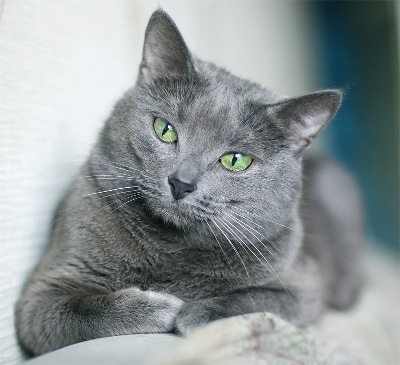Russian Blue Cat
Category: Cats

Facts about Russian Blue Cat "Scientific name for Russian Blue Cat is Felis Catus". Russian Blue Cat is intelligent and independent are the two words that best describe this Cats. The Russian Blue Cat show moderate interest in activities and have a playful attitude. The Russian Blue Cat get along easy with other pets and are very affectionate to children.
A Russian Blue Cats jaw can not move sideways, there for a cat can not chew large pieces of food. A Russian Blue Cats back is highly flexible because of its 53 loosely fitting vertebrae. The body of a cat has 230 bones. While a human body has 206. Compared to a humans who only have 34. The average Russian Blue Cat temperature of a cat is 101.5 °F. The Russian Blue Cats heart beats at 110 to 140 a minute, That is almost twice as fast as a human heart. Russian Blue Cats weigh up to 12 pounds (5.4 kg) and grow up to about 10 inches (25.4 cm) of height. The Russian Blue Cat are ideal for working singles, people having a cat as a pet for the first time and families with older children.
Identifying Traits
The Russian Blue Cats mostly have plush blue coats. The Russian Blue Cat show gentle behavior and feel shy with strangers. The Russian Blue Cat take enough time to get along with strangers, but once they are familiar with the person, they feel comfortable.
Russian Blue Cats on average sleep 13 to 14 hours a day and when they are awake, the spend a lot of time licking themselves to keep themselves clean. Russian Blue Cats help control rodents like small rats and mice where the live homes, warehouse, ect. A female cat is called a "queen or molly", male cat is called a "tom" and the name "clowder" is called a group and young or baby cats are called kittens. Russian Blue Cats prefer to be on a schedule. Unlike other cat breeds, they like cleaner environments. The Russian Blue Cats even require clean litter boxs. If their litter boxes are not replaced or cleaned, they do it some other place. The Russian Blue Cat are a little silent type and hence easily trainable. As said earlier, the Russian Blue Cat are independent. The Russian Blue Cat can play, roam and rest as long as the food and litter boxes are taken care of.
Appearance
The Russian Blue Cat is known for its uniform plush blue coat. Each hair on its body has silver tipping that result in a silvery sheen. The Russian Blue Cat has a cobra like face, large rounded eyes in a wedge shaped head. Ears are bigger in comparison to size of its head. The body of the Russian Blue Cat appears to be fine boned and firmly muscles. The Russian Blue Cat makes a shiny, eye catchy and elegant appearance.
The Russian Blue Cat was called Archangel Cat, back in 1875 in England where it made its first show. The Russian Blue Cat breed was then imported to United States in 1990. During World War II, the breeding was stopped and it was almost lost. However, the plushy blue coat and the behavior of the Russian Blue Cat started breeding in 1940s.
Cat Facts
There are over 500 million domestic cats in the world and 88 million in the United States Approximately 40,000 people are bitten by cats in the U.S. annually. Domestic cats have an average weight around 8.7 to 11 pounds (3.9 to 5 kg). Russian Blue Cats have very sharp hearing and their sense of smell is fantastic. Russian Blue Cats average life span is around 12 to 15 years. The reason why Russian Blue Cats can squeeze through very small spaces is that they have no collarbone and free-floating clavicle bones that their shoulders are attach to their forelimbs, that's why a cat can fit through a hole the same size as its head and the Russian Blue Cat use their whiskers to determine if they can fit through the space.
Russian Blue Cats can see at levels of light six time lower than a human, this is why cats can catch mice so easily at night. Russian Blue Cats outer ear uses 32 muscles to control it, and a human has only 6 muscles in its ear and a cat can move its ears 180 degrees. A Russian Blue Cat can move their ears independently. The cat's hairball is called a "bezoar" (meaning a concretion or calculus found in the intestines or stomach of certain animals, in particular ruminants, formerly alleged to be an effective cure for poison). A Russian Blue Cat can climb up a tree well but can not climb head first down a tree, because all the claws on a cat’s paw points the same direction, to get down from a tree, a cat has to back down. A Russian Blue Cat can run at a top speed of about 30 mph (48.2 km) over a short distance. A cat rubs against a person to not only to be affectionate but also to mark out its territory. A Russian Blue Cat does not like water because its fur is not insulate it well when it gets wet. A cat averages about 12 whiskers on both side of its face. A Russian Blue Cats has 30 teeth while a kittens has about 26 teeth that they will lose at about 6 months of age. A Russian Blue Cat has the ability to jump up to six times its length.

 Back To Category Cats
Back To Category Cats